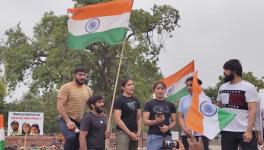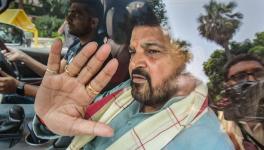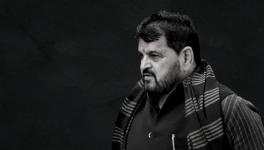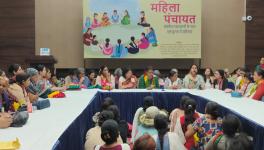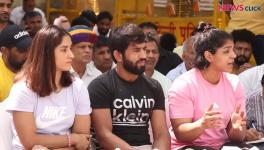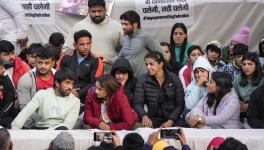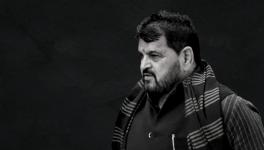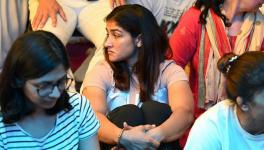Story of Indian wrestling’s Greco-Roman Stepson
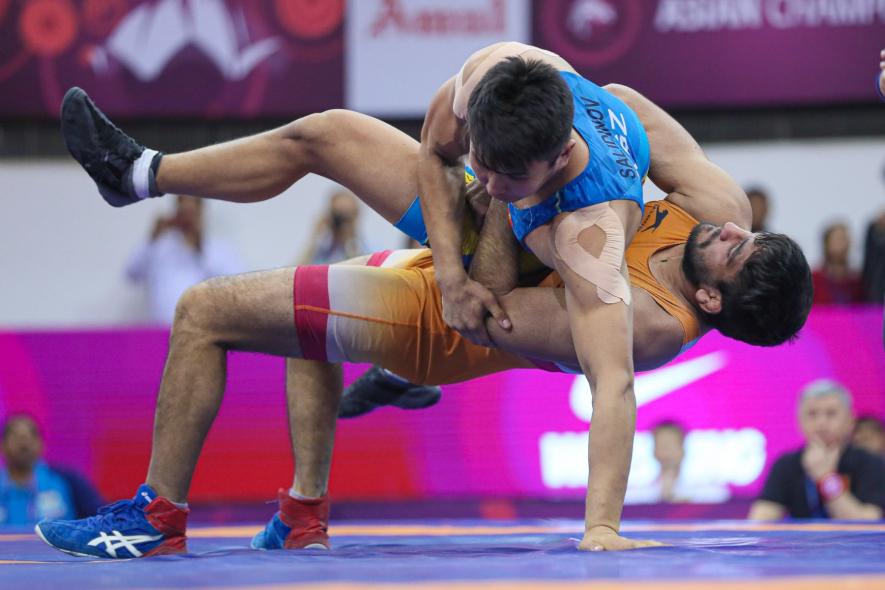
Sunil Kumar executes a gut-wrench roll to take the lead during his final against Azat Salidinov in the final of the 2020 Asian Wrestling Championships in New Delhi.
Pappu Yadav was the first to rise from his seat. He rose with his arms in the air, much before the burst of applause rang from the crowd. Through the course of the agonising minutes of the 87kg Greco-Roman final at the Asian Wrestling Championships, he was flailing his arms about, making gestures a scant few could decode — a ball of nervous energy exploding far away from the action, with no control over it. He was a fan, but he was also more.
Yadav, the fan, wanted the wrestler on the mat, the Greco-Roman Indian (love the pun), a boy in his second consecutive Asian Championships final, to win that gold and break a streak of near misses. Yadav, the former wrestler — the last Indian to win gold in the discipline at an Asian Championship — wanted an old record matched.
And so when it happened — 15 seconds before it officially did, in fact — Yadav was up on his feet cheering India’s first gold in the event in 27 years. To put that in perspective: Sunil Kumar, the grappler who broke that long barren drought, is 21.
Also Read | Mat Finished: A Wrestling Icon’s Bout Against Time
“It feels good. It feels really good that finally that duck is broken,” Yadav said, a smile beaming across his face. Across the wrestling hall, in the mixed zone, surrounded by journalists minutes earlier, Sunil expressed a similar sentiment. This was a personal milestone. A huge boost for a young career.
But Yadav’s sentiments went deeper. This wasn’t individual pursuit, it was collective vindication. Redemption for a wrestling form much downtrodden in the country. (So downtrodden, in fact, that this website sent its not-so-regular wrestling reporter to cover the day’s events).
And why wouldn’t it be. Greco-Roman, like the name suggests, is alien to India.
A Greco-Roman wrestler in India is a freestyle wrestler gone rogue (or in some cases a freestyle wrestler settling into the style for lack of success). This much is true no matter how far you look within the wrestling spectrum in India. Sunil’s story is a fairly simple one. He was a freestyle wrestler with a weakness executing lower body attacks, and shifted disciplines upon the advice of a senior in his training centre. He found success quickly, and rose through the ranks to stamp his authority as a talent to reckon with. Last year, at the same event, he was that close to history in the 85kg category, beaten by Iran’s Hossein Ahmad Nouri in the final.
At the KD Jadhav indoor stadium on February 18, there would be no repeat. Partly because his Iranian nemesis (not the same, but of the same mould) injured himself in his semifinal bout with seconds to go for the finish. Despite leading handsomely, he was forced to forfeit and allow Azat Salidinov of Kyrgyzstan to progress to the final. Sunil — who had fashioned a comeback of his own in the semifinal, clawing back from an eight point deficit — was favourite on form and on home ground.
Also Read | Sole for a Soul: Nike’s Chokehold on World Athletics
As much as Sunil’s story is unique and heartwarming, it isn’t too dissimilar to Arjun Halakurki, the 21-year-old in his first senior international wrestling championships. He bagged a bronze in the 55kg category. Halakurki is from Bagalkot, a wrestling bastion in Karnataka. Following in the footsteps of his freestyle wrestler father, he took up the sport and the discipline favoured by most of India. For 11 years he toiled but rarely succeeded. Four years back he made the transition to Greco-Roman. Last year, he became the first wrestler from Karnataka in over 25 years to win gold at the nationals. And at the Asian Championships, for all of Sunil’s brilliance, Halakurki could have pipped him to the post, if he had a little more experience and a lot more calm. He was leading his semifinal 7-1 with less than a minute to go, before capitulating to lose 7-8.
“Indian style of wrestling is closest to freestyle,” national coach Hargobind Singh says, “Greco-Roman is an alien concept for most wrestlers at the grassroot level. At dangals and junior district competitions there is no Greco-Roman.”
As a result, it is inevitable that most wrestlers that end up grappling in the Greco-Roman discipline come after learning the trade the freestyle way. As Hargobind puts it, lack of success, a coach with an astute eye and a wrestler with an easily malleable personality are key components that aid the transition.
“Even I became a Greco coach only because of circumstances,” he says. Hargobind is a former national champion in freestyle wrestling, and, as a coach, was charged with a team that was to take part in a national tournament. “There were two teams, and the deal was that whichever side lost would take part in Greco. As luck would have it, it was my team and so we went to Greco. And soon after I shifted,” he adds.
In the early days, the days before YouTube videos and Twitter voyeurism, coaches learnt their trade through conversations and verbal advice, and research. Hargobind travelled to tournaments with his wards and picked up tips from European coaches. He borrowed and bought many books that aided him in learning techniques to teach his students. Within a few years, he was at the Sydney Olympics in the role of 63 kg Greco-Roman Gurbinder Singh’s personal coach.
“The transition is unique, but if the wrestler is young and impressionable it isn’t tough to make,” hargobind says. With Halakurki he didn’t have to change much. Even as a freestyler Halakurki’s stance was fairly upright and so all Hargobind had to do was improve his conditioning and teach him new techniques. “If you have to change the stance then you have to take several steps back,” he says, “That requires a realignment of muscle memory. Wrestlers can get disheartened easily. Teaching them techniques is easier.”
But even in technique, Indian wrestlers have traditionally suffered, because of a late start — a fact multiple foreign coaches attached with the Greco-Roman national side in the past, have pointed out vociferously. It has to do with how they began their careers. In strong wrestling nations, Greco-Roman wrestlers begin and end their careers in the discipline. Coaches identify talent early (when they are 8-10 years of age) and inculcate the values right at the start.
In India, the transition happens — as evident in the cases of Sunil and Halakurki — in the late teens. By then the learning and unlearning, and recalibrating muscle memory is taxing for the athlete. In essence, it makes a national level wrestler a novice while facing internationals.
While teaching the techniques is easy, drilling it to a point where they apply it without much thought is much tougher. Hargobind points out that Halakurki’s failure in the final stages was down to his inexperience at the elite level. “The more he faces adversity, the better he will get,” the veteran coach says.
Also Read | SAI Kokrajhar: Tales From an Indian Sports Outpost
The importance of the upright stance in Greco-Roman — something Hargobind takes care to mention several times — compared to the hunched, low centre-of-gravity fighting position in freestyle, is just the tip of the iceberg. The art form is obviously much more complex than that.
With a change in style, application of techniques differ too. Most of the time, in Greco-Roman, leverage used for lifting and throwing, needs to be generated from above the centre of gravity of the opponent (freestylers have the luxury of using physics). This means body conditioning needs to change.
The specificity of the techniques are massively different too. Greco-Roman wrestlers thrive on pummeling and establishing underhooks in a standing position. An inside grip allows them to attempt suplexes. While pummelling is common in freestyle too, the style and approach angle of the body is drastically different.
On the ground, gut-wrench rolls and lift and throws, including suplexes (back salto) are common. These are rarely used in freestyle and when a freestyler wrestler shifts to Greco-Roman at, say, 16, he is asked to do things he has rarely done on the mat prior to that.
With all these roadblocks, Sunil’s gold needs acknowledgement, no matter the quality of field on display.
Also Read | Bajrang Punia’s Millennial Dilemma
And, as much as the medal is a new dawn for the discipline, Hargobind says the revolution has been brewing for some time. He maintains that India’s Greco-Roman wrestlers still have a way to go to catch up with the Europeans, but at the Asian level he thinks his wards are almost there. But there is much to be done.
“Some of the big problems are that there is no Greco-Roman at Commonwealth Games. The Pro-League also doesn’t have it. It's obvious. Wrestlers won’t opt for it if there is no potential for competition and reward,” he says. The lack of competition extends beyond India’s borders. “If a European Greco-Roman wrestler wants to compete at events and gain exposure, they can travel to a neighbour and there will be a tournament happening. Almost every country there is good in the discipline. Here, we have to travel very far in Asia to find competition worthy of attention.”
This much is true. Despite Sunil and Halakurki’s success, the lack of quality in the field is glaring. Asian competitions aren’t the hub of Greco-Roman greats. The fact is magnified by it being an Olympic year, and the Asian qualifiers not too far away. Too many good wrestlers have given the Delhi event a skip.
For those watching, and rejoicing in that first gold in a quarter century these facts aren’t worth discussing. “I always come and watch the Greco event,” Yadav says. “Everyone gears up for the freestyle and they schedule it as such also, but people like me come and watch the Greco. And today, the faith has been repaid in gold.”
(With Inputs from Leslie Xavier)
Get the latest reports & analysis with people's perspective on Protests, movements & deep analytical videos, discussions of the current affairs in your Telegram app. Subscribe to NewsClick's Telegram channel & get Real-Time updates on stories, as they get published on our website.









